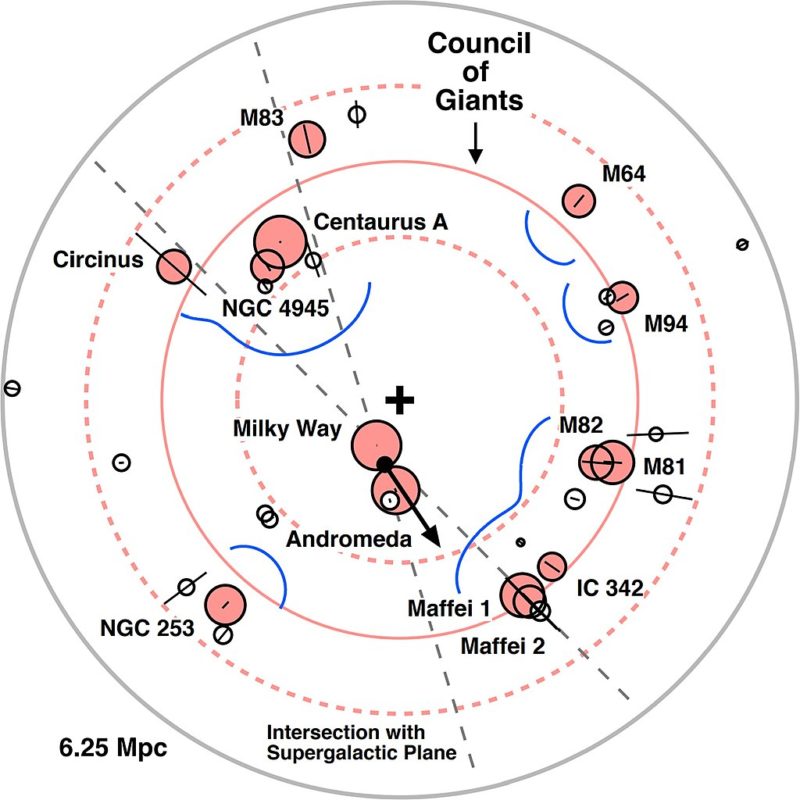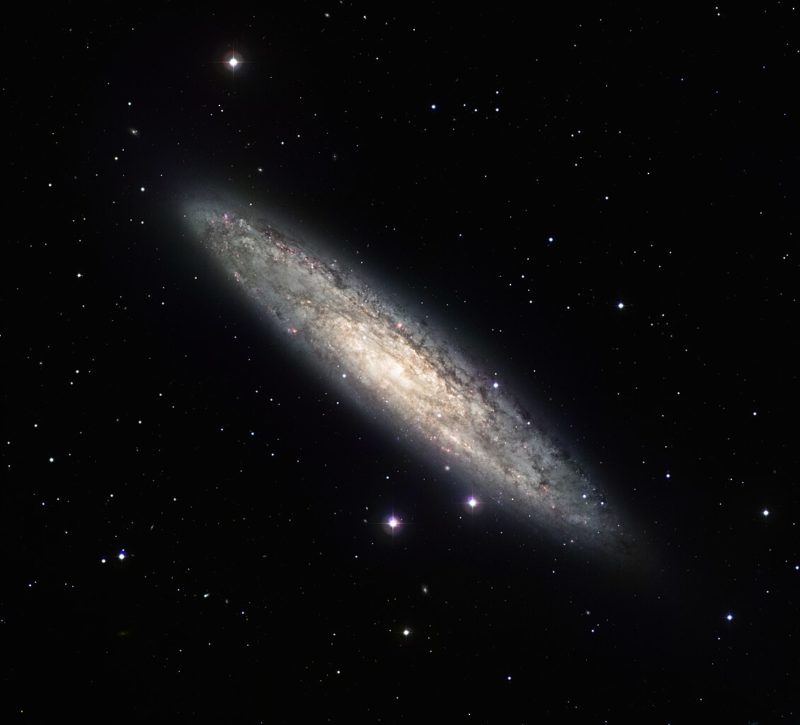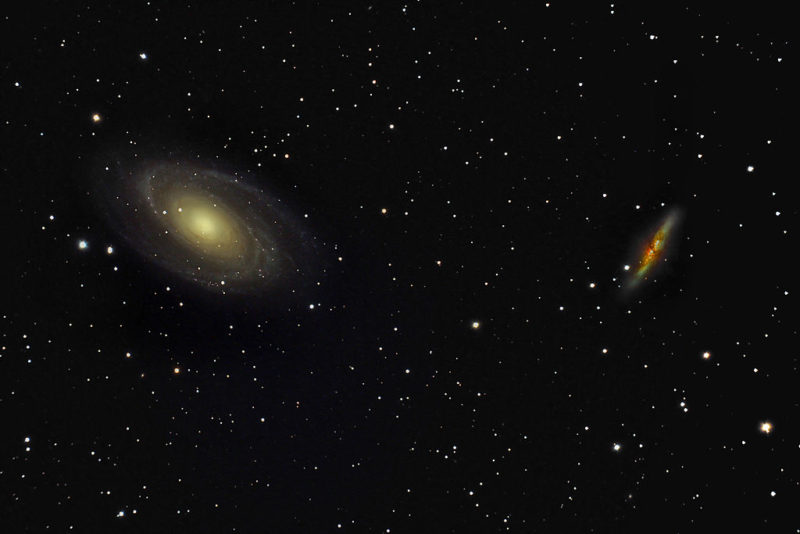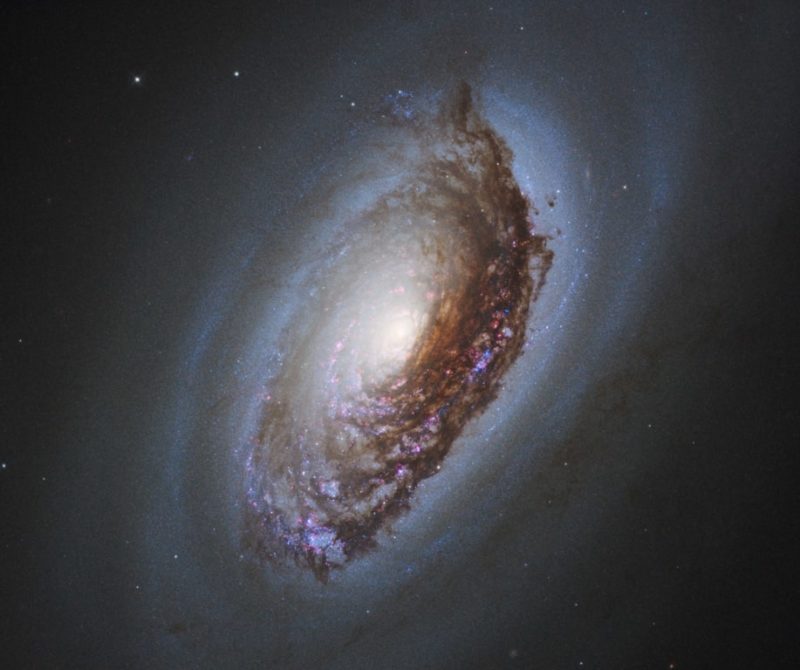
The Council of Giants is a ring of twelve large galaxies surrounding our Local Group in the Local Sheet. The Local Group includes our own Milky Way galaxy, Andromeda and Triangulum galaxies, as well as many smaller and dwarf galaxies.
The Local Sheet, on the other hand, is a much larger grouping of galaxies that extends in a radius of about 23 million light-years from us. The Council of Giants is located in a ring about half way between us and the edge of the Local Sheet at an average of 12.2 million light-years away. There are some deviations from that, from as little as 11 million light-years to as much as 16 million light-years, as the ring of galaxies is not a perfect circle.
Of these galaxies in the Council of Giants, ten are spirals, while the remaining two are ellipticals. Let’s delve into each one at a time.
Sculptor Galaxy


NGC 253, also known as the Sculptor Galaxy, is located approximately 11 million light-years away in the constellation of Sculptor. Notable for its sprawling arms hosting areas of active star formation, NGC 253 showcases clusters of nascent stars that illuminate its expanse. Within its spiral arms, wisps of cosmic dust add an air of enigma, enticing astronomers to uncover its mysteries.
It is classified as an intermediate spiral galaxy. This categorization places it in between a barred spiral galaxy and an unbarred spiral galaxy. Its well-defined spiral arms display a remarkable structure that facilitates the ongoing formation of stars. This intermediate classification adds another layer of interest to NGC 253, contributing to the diversity and richness of the Council of Giants’ galactic assembly.
What distinguishes NGC 253 further is its status as one of the closest starburst galaxies to the Milky Way. This designation arises from its intense and ongoing star formation, making it an invaluable celestial laboratory for scientists studying the intricacies of cosmic evolution and the dynamics of stellar birth. Wisps of interstellar dust intricately weave through the galaxy’s arms, casting an aura of mystery and providing a playground for astronomers to explore the processes that shape and sculpt galaxies.
Maffei 1 Galaxy
The Maffei 1 galaxy, a member of the Council of Giants, presents a captivating enigma within the cosmic ensemble. Its distinction lies not solely in its cosmic presence but in its obscured visibility owing to interstellar dust and the plane of our Milky Way galaxy, in what is known as the Zone of Avoidance. Located in the constellation of Cassiopeia at a distance of about 11 million light-years, Maffei 1 stands as one of the closest known giant elliptical galaxies to our own, yet remains concealed behind the veils of cosmic dust, evading easy detection by optical telescopes.
This obscured positioning amidst the dust clouds of our own galaxy has obscured Maffei 1 from plain view, making its observation challenging in visible light. However, observations in infrared and radio wavelengths have unveiled this elusive giant elliptical galaxy, revealing its immense size and stellar population. Despite its proximity, the challenges in observing Maffei 1 have made comprehensive studies and detailed observations a more recent endeavor.
Once thought to be a constituent of the Local Group due to its proximity, Maffei 1 has revealed its true cosmic allegiance, belonging to a distinct galactic grouping known as the IC 342/Maffei Group. This revelation reshapes our understanding of its cosmic environment, situating it within a different galactic congregation separate from the familiar confines of the Local Group. The IC 342/Maffei Group hosts a collection of galaxies, including the spiral galaxy IC 342 and other cosmic members.
Maffei 2 Galaxy
The Maffei 2 galaxy stands as a notable member within the cosmic tapestry of the Council of Giants, positioned at a distance of approximately 11 million light-years away in the constellation of Cassiopeia.
Much like its sibling, Maffei 1, this galaxy has remained elusive to conventional optical observations due to its obscured visibility behind the veils of interstellar dust and the galactic plane of our Milky Way. Despite its relative proximity, Maffei 2 eluded detection for decades until its discovery in the mid-20th century through infrared observations, revealing it to be an intermediate spiral galaxy.
Being a member of the IC 342/Maffei Group, alongside Maffei 1, aligns it with a distinct galactic gathering beyond the bounds of the Local Group, emphasizing its unique cosmic association.
IC 342 Galaxy


IC 342, affectionately known as the Hidden Galaxy, is located in the constellation of Camelopardalis at a distance of approximately 11 million light-years from Earth. It is also a member of the IC 342/Maffei Group along with the two Maffei galaxies discussed earlier.
Despite its relative proximity, this intermediate spiral galaxy eludes casual observation due to its alignment near the plane of the Milky Way, shrouded by dense clouds of interstellar dust that obscure its visibility in visible light wavelengths.
Messier 81 Galaxy


Messier 81 (also known as NGC 3031) occupies a prominent position among the cosmic congregation within the Council of Giants. Located approximately 12 million light-years away from Earth in the constellation of Ursa Major, this grand design spiral galaxy showcases a spectacular display of structure and activity. Its proximity and orientation, presenting an almost face-on perspective to observers, make it an exquisite subject for detailed astronomical study. It is a member of the M81 Group along with Messier 82.
This resplendent spiral galaxy stands out for its well-defined spiral arms adorned with regions of intense star formation. Enveloped within these spiraling cosmic arms lie clusters of young, luminous stars, illuminating the galactic expanse with their brilliance.
Moreover, the central region of Messier 81 harbors a supermassive black hole, a feature common in many large galaxies. The interaction of this black hole with its surrounding environment offers a captivating avenue for researchers to delve into the intricate interplay of cosmic forces within galactic cores.
Messier 82 Galaxy
Messier 82, commonly known as the Cigar Galaxy or NGC 3034, is located at a distance of approximately 11 million light-years from Earth in the constellation of Ursa Major. Along with its neighbor Messier 81, it is a member of the M81 Group.
Messier 82’s designation as a starburst galaxy emphasizes its status as an astronomical laboratory for studying the rapid and intense birth of stars. The energetic processes within this galaxy provide invaluable insights into the mechanisms fueling cosmic evolution and the impact of intergalactic interactions on the life cycles of galaxies.
Messier 94 Galaxy


Messier 94, also known as NGC 4736, is situated approximately 15 million light-years from Earth in the constellation of Canes Venatici. It is a member of the M94 Group (or Canes Venatici I Group), a loose, extended group of galaxies. This stunning spiral galaxy distinguishes itself with a distinct structure characterized by a bright central core encircled by a prominent ring of star formation.
One notable feature of Messier 94 lies in its inner region, showcasing an unusual starburst ring enveloping the core. This phenomenon, referred to as a star-forming ring, signifies a concentrated area of active star formation. The unique arrangement and structure of this galaxy have garnered interest among astronomers, offering a glimpse into the complex interplay of cosmic forces shaping the evolution of galaxies within the Council of Giants.
Black Eye Galaxy (Messier 64)


The Black Eye Galaxy, designated as Messier 64 or NGC 4826, emerges as a celestial gem within the grandeur of the Council of Giants, positioned approximately 16 million light-years away from Earth in the constellation of Coma Berenices. This captivating spiral galaxy earns its moniker from a prominent dark band of dust that swathes across its bright core, resembling an enigmatic cosmic eye amidst the starry canvas.
What distinguishes Messier 64 is its unique and striking feature—the presence of an intriguing dark structure known as a “dust lane” or “absorption lane.” This lane, comprised of cosmic dust and gas, casts a stark contrast against the galaxy’s luminous core, resulting in its distinctive appearance resembling a darkened eye in the cosmic expanse. The origin and nature of this feature remain a source of fascination and ongoing study among astronomers seeking to unravel the mysteries cloaked within this cosmic spectacle.
Southern Pinwheel Galaxy (Messier 83)


The Southern Pinwheel Galaxy, also known as Messier 83 or NGC 5236, is located approximately 16 million light-years from Earth in the constellation of Hydra. It is a member of the Centaurus A/M83 Group, along with Centaurus A and NGC 4945, which are also members of the Council of Giants.
This exquisite barred spiral galaxy captivates observers with its grandeur, showcasing tightly wound arms adorned with clusters of luminous stars, vividly depicting a celestial pinwheel in the vast expanse of space.
What distinguishes Messier 83 is its remarkable vibrancy and ongoing stellar birth. Within its spiral arms, regions teeming with active star formation paint the galaxy with clusters of young, hot stars that illuminate its sprawling structure. The vibrant hues of these stellar nurseries contribute to the galaxy’s striking appearance, highlighting its role as a prolific cosmic birthplace.
Centaurus A Galaxy


The Centaurus A galaxy, also known as NGC 5128, is situated approximately 11 million light-years away from Earth in the constellation of Centaurus. It is a member of the Centaurus A/M83 Group within the Council of Giants. This enigmatic galaxy boasts a captivating appearance characterized by a striking dust lane bisecting its core, contrasting the luminous glow emanating from its central regions.
Centaurus A showcases powerful radio emissions and jets of high-energy particles streaming from its core, indicative of an active galactic nucleus. These emissions, believed to originate from the supermassive black hole at its heart, contribute to its status as an active galaxy and render it a compelling subject for studying the complex interplay of cosmic forces within galactic environments.
NGC 4945 Galaxy
NGC 4945 is a captivating barred spiral galaxy situated approximately 13 million light-years away in the constellation of Centaurus. It is also a member of the Centaurus A/M83 Group within the Council of Giants. This celestial beauty enthralls observers with its distinct structure—a barred central region extending outward into sweeping spiral arms adorned with clusters of bright stars and cosmic dust.
Moreover, NGC 4945’s central region houses a supermassive black hole, a common feature found in the hearts of many galaxies. This black hole exerts a profound gravitational influence, impacting the galaxy’s dynamics and contributing to the cosmic phenomena observed within its vicinity.
Circinus Galaxy
The Circinus Galaxy, nestled within the cosmic assembly of the Council of Giants, stands out as a unique and enigmatic Seyfert galaxy positioned approximately 14 million light-years away from Earth in the constellation of Circinus. It is also located in the Zone of Avoidance, making it very difficult to observe.
Circinus exhibits a highly active galactic nucleus, featuring a supermassive black hole shrouded by a dusty torus. The dynamic interplay between this central black hole and its surrounding environment gives rise to intense emissions across various wavelengths, rendering Circinus an active galactic nucleus.
Conclusion
Within the cosmic ensemble of the Council of Giants, each galaxy stands as a unique celestial marvel, offering a window into the diverse tapestry of cosmic evolution. From the intricate structures of spiral arms and enigmatic dust lanes to the energetic cores hosting supermassive black holes, galaxies like Sculptor, Messier 81, and Centaurus A reveal the dynamic interplay of cosmic forces shaping their existence.
Their active star formation regions and peculiar features beckon astronomers to unravel the mysteries of galactic evolution, while their accessibility promises deeper insights into the cosmic narrative. Together, these galaxies within the Council of Giants offer a rich canvas for exploration, enriching our understanding of the cosmic symphony playing out across the vast reaches of our universe.
Source: McCall, Marshall L. (29 April 2013). “A Council of Giants”. Monthly Notices of the Royal Astronomical Society (published 10 March 2014). doi:10.1093/mnras/stu199.